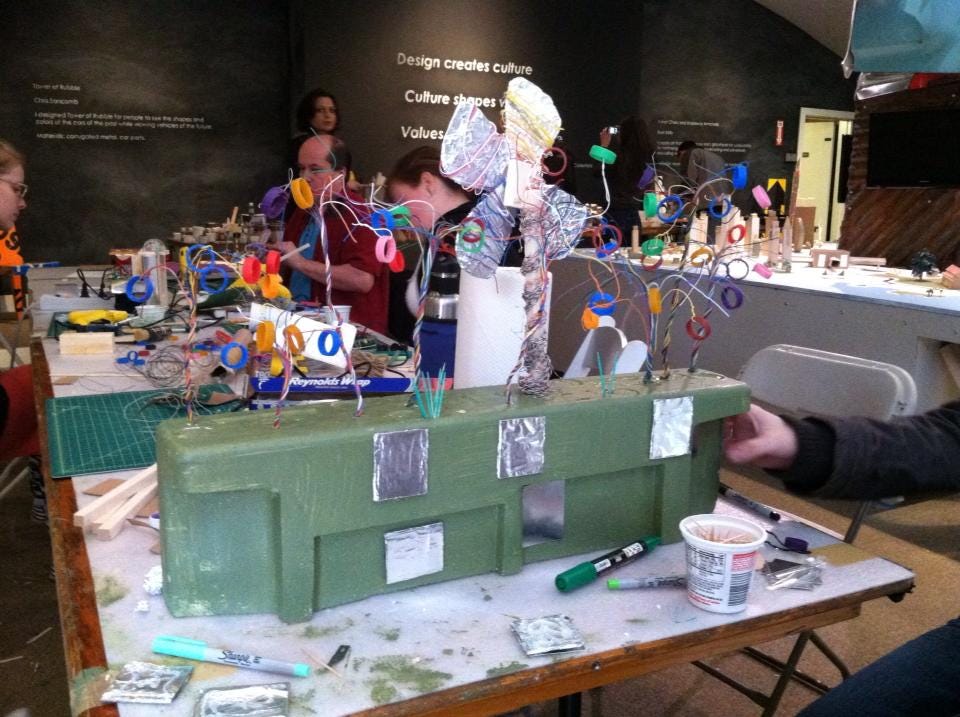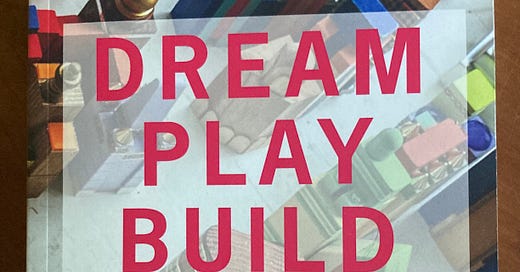When I speak with planners about my exhibit development work and they about their community engagement work, we often realize how similar some of our community/visitor engagement practices are. This post is a case in point.
One tried-and-true methods for getting people to express their vision for the future of a city or town is to have them construct a model of that vision. Looking at these examples from museums and from planners, I’m struck by the ways model-building activities can accomplish different engagement goals.
Goal: Improving Community Input into Neighborhood Redevelopment Plans
Place It! Community Model-Building Events
James Rojas and John Kamp of the urban planning firm Place It! have honed a community visioning process using a mix of found objects to spark – and capture – people’s local knowledge about and desires for the future of their neighborhood. Their methodology grew out of their dissatisfaction with traditional planning community engagement processes.
To vastly over-simplify their work, they use a set of non-specific loose parts and simplified not-to-scale neighborhood maps on foam core in their events. They have found that this approach broadens meaningful public input in several ways:
The non-specific objects (hair curlers, colorful wooden blocks, artificial flowers) aren’t precious or intimidating, and they allow people to imbue the objects with specific meanings.
Combined with great warm-up prompts, like “Build Your Favorite Childhood Memory”, the hands-on activity serves as an icebreaker between participants as they share their place-based stories.
It doesn’t rely heavily on written or verbal language skills to participate. It is very distinctly unlike a typical “open” public hearing where the most boisterous, fired-up, and/or privileged NIMBYs get the greatest input.
As we museum folks know, what people build and what they say about what they built are data. Place It! has worked out a system to capture people’s designs and their words to identify common ideas, design features, and visions. Place It! then incorporates this community data into the designs and plans they bring back to the neighborhood. However, the firm also places significant value on the non-tangible outcomes of their process:
New and strengthened relationships within the community and across social divides,
Increased feelings of empowerment and trust in government, and
Increased confidence in one’s own abilities to think about design and participate in planning.
I highly recommend getting their book Dream, Play, Build: Hands-on Community Engagement for Enduring Spaces and Places (Island Press) to understand all of their methodologies. It will set your museum practioner heart fluttering.
By the way, the Place It! folks have brought these methods to museums, including events at the Riverside Art Museum’s Cheech Marin Center for Chicano Art & Culture and to the Exploratorium in San Francisco (where Rojas* also played DJ).
[*CORRECTION (1/18/24): at the Exploratorium event, James built the model, and John Kamp was the DJ. You can listen to sets from PlaceIt’s most recent hybrid model-building/DJ event (aka Tracks to Build to) here: https://djjohnnycakes.com/]

Goal: Practicing Design-Process Skills
Heritage Museums and Gardens’ “Cardboard City”
When she was Exhibit Manager at Heritage Museums and Gardens in Sandwich, MA, Jan Crocker was charged with creating a companion exhibit to an exhibition of mid-20th Century model concept cars – those futuristic Detroit “dream cars” that rarely made it to production. The companion exhibit was to be in a separate building that couldn’t physically accommodate any cars.
So, Crocker leaned on the fact that designing cars for the future meant thinking about the future context for those cars, noting “When you think of futuristic cars, it’s about urban planning.” As a designer herself, it was natural to make the exhibit focus on the design process skill-building.
She brought in L.A. artist Kiel Johnson who had done community visioning projects in post-earthquake Christchurch, NZ, to engage community members in building a future concept city in cardboard. The non-specific city, which served as a centerpiece of the exhibition, was built from arts and crafts materials (and, yes, cardboard) during hands-on workshops. During regular exhibit hours, visitors added to the exhibition on chalkboards at the periphery of the gallery, responding to prompts and information about global urbanization trends sprinkled throughout.
Her exhibit goals were about engagement in the design process itself, so collecting data about people’s specific designs wasn’t part of the plan. But I will note that anecdotally, she noticed the same optimism that many of us see when asking people their vision for the future: “I mean, there’s always the flying car [but] they built green spaces, rooftop gardens, elder care facilities, lots of trees … one family made a ‘Museum of Finer Art’”. And like Rojas and Kemp, she noticed people engaged in conversations with other groups as they built their models – sharing ideas and taking inspiration from each other. Check out this fabulous video by Chris Sancomb about the project.
And, for a discussion of the logistics of using cardboard city as an ongoing gallery activity rather than an episodic program, check out this project by Science Museum of Minnesota.
Goal: Proof of Concept - Embedded Evaluation
Magnetic Neighborhood Interactive
In the City Science exhibition’s neighborhood design interactive at the EcoTarium, we also wanted to capture people’s designs, but not to inform a specific community design. We were testing the activity as a potential embedded evaluation tool. We wanted to learn whether using interactives about urban habitats, land use, and heat island effect influenced the amount of green space that visitors would put into their city neighborhood designs.1
During prototyping, drawing-based activities proved unworkable for an unstaffed exhibit interactive and as an evaluation tool. And the number of features in their designs was very small; what they drew was measly compared to what they told us they envisioned for their neighborhood. So, we create a comprehensive set of magnetic pieces: green spaces, buildings, transit corridors, and water bodies, each sized according to their relative footprint. This “Magnetic Neighborhood” interactive invited visitors to design their ideal neighborhood. Folks of all ages spend 10 – 20 minutes -often more - designing their neighborhood on small metal trays. For my non-museum readers, 20 minutes at one interactive is an eternity in museum time; we count 60 - 120 seconds as a good “hold time.”

Originally, we hadn’t wanted to limit people’s imaginations by seeding the activity with pre-set pieces. However, we found that giving people a superabundance of options and a very restricted “land area” forced them to grapple with the costs and benefits of each potential land use. Cost-benefit analysis hadn’t been one of our original exhibit goals, but it repeatedly emerged as a theme at multiple City Science interactives, so we looked to amp this up whenever we could.
And, like the two examples above, “Magnetic Neighborhood” sparked a lot of conversation. Here’s what one visitor wrote about the exhibit in a letter to the editor of the local paper:
“One of our favorite displays at the exhibit was a hands-on activity to design your ideal neighborhood… We shared the choices we made and the reasons we made them. Our visions for a good city were different. My [9-year-old] son turned to me and asked, ‘Now mommy, can we build one together?’”
~ Joyce Mandell, Jane Jacobs in the Woo.2
Three different missions – accomplished!
In researching an image for this piece, I’ve come across several cardboard city-building activities specifically targeting kids and their families, which may become a story for another day. But what these three projects highlight is that there is tremendous value in giving Grown-ass Adults some arts and crafts supplies, a personally meaningful prompt, and the time and space to connect with others by sharing their designs.
~ Betsy Loring3
The Planning-Curious Museum Person
Sharing stories and ideas for other Planning-Curious Museum People and for Museum-Curious Planning People.
Did it work as an evaluation tool? Maybe. With the limited pilot-level funding we had, we could only run a manual proof-of-concept test – a small number of subjects captured by lots of grad students scoring photos of people’s designs. But visitor interviews and designs did seem to indicate that people were thinking about the environmental benefits of the green spaces they put in their designs. (It was promising enough that If I had a giant pot of money, I’d definitely want to test Magnetic Neighborhood with an AI-driven scanner analyzing people’s designs. Just want to put that out in the universe.)
By the way, we talk about (the original) Jane Jacobs in my interview with urban planner Wendell Joseph, and I give several links to information about her in my notes.
Betsy Loring is founder of expLoring exhibits & engagement. She has over 20 years’ experience in project management and exhibit development in multidisciplinary, indoor and outdoor museum settings. Her services include exhibit master planning, content and interactive development, and writing, with a focus on hands-on STEM. She also offers staff training in exhibition planning, formative evaluation, and prototyping. Special interests include multi-institutional collaborations, peer-to-peer professional development, and of course – collaboration with municipal planning practitioners.




